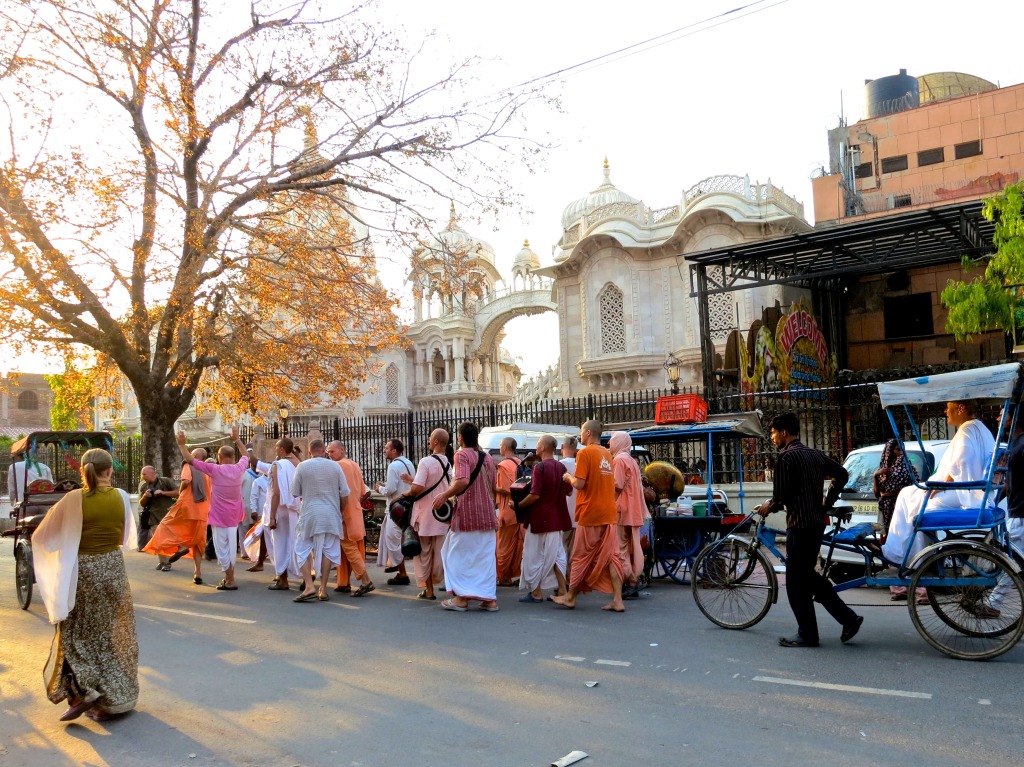
Hare Krishnas dance and chant outside of Krishna Balaram Mandir, ISKCON’s principal temple in Vrindavan, India
“How do these look?” Sita dasi asked, emerging from the dressing room and checking herself out in the mirror. “Oh my God, so good!” her friend Govinda dasi exclaimed. “Try this on, too.”
I was out shopping for the third day in a row with these two American teenage girls in the Indian city of Vrindavan, about one hundred miles southeast of New Delhi. We had been wandering in and out of shops all day, taking occasional breaks to eat sweets, say hello to someone they knew, or stop to chant 108 rounds of “Hare Krishna” in the nearest Gaudiya Vaishnava temple.
Govinda and Sita are what most people would call “Hare Krishnas,” though they prefer the term “devotees” of the Krishna Conscious movement. Vrindavan is located in the state of Rajasthan and is a site of pilgrimage for Krishna worshipers from all around the world.
I traveled to the city last year to interview Syamarani didi (‘dasi’ is the feminine honorific appended to devotees’ guru-given names, ‘dasa’ is the masculine, and ‘didi’ means ‘sister’ and is used for the highly respected). One of the last remaining Hare Krishna nuns and one of the movement’s earliest devotees, Syamarani was personally tutored by the religion’s founder and instructed to train Hare Krishna artists around the world in temple painting and scripture illustration. She is a New York native but hasn’t had a permanent home since the 1970s. Instead, Syamarani travels continuously, giving lectures and lessons, and is constantly followed by an assistant and a rotating band of followers.
The International Society for Krishna Consciousness (ISKCON) was founded by the Indian Hindu guru Srila A. C. Bhaktivedanta Swami Prabhupada, or “Prabhupada” for short, under a tree in Manhattan’s Tompkins Square Park in 1966. Prabhupada is said to have sat down in the shade and begun chanting. He chanted every day until some young people took notice and brought over drums and instruments. The drumming and chanting eventually turned to talking about Krishna, and soon after that, the drum circle coalesced into a religious movement.
As its fiftieth birthday nears, ISKCON is undergoing a midlife crisis. Syamarani didi belongs to the movement’s founding generation, whose members see themselves as re-discoverers of an ancient tradition. But for younger devotees, Krishna Consciousness is an inherited faith known since birth. I began to notice generational fault lines soon after meeting Syamarani’s younger followers, like Sita and Govinda, but when I asked Syamarani didi about it, she smiled, and then declined my request for an interview. Instead, she offered me her entire unpublished autobiography, hundreds of photographic slides of the early days of the Hare Krishna movement, and an invitation to live with her and her followers for a few weeks in Vrindavan that spring.
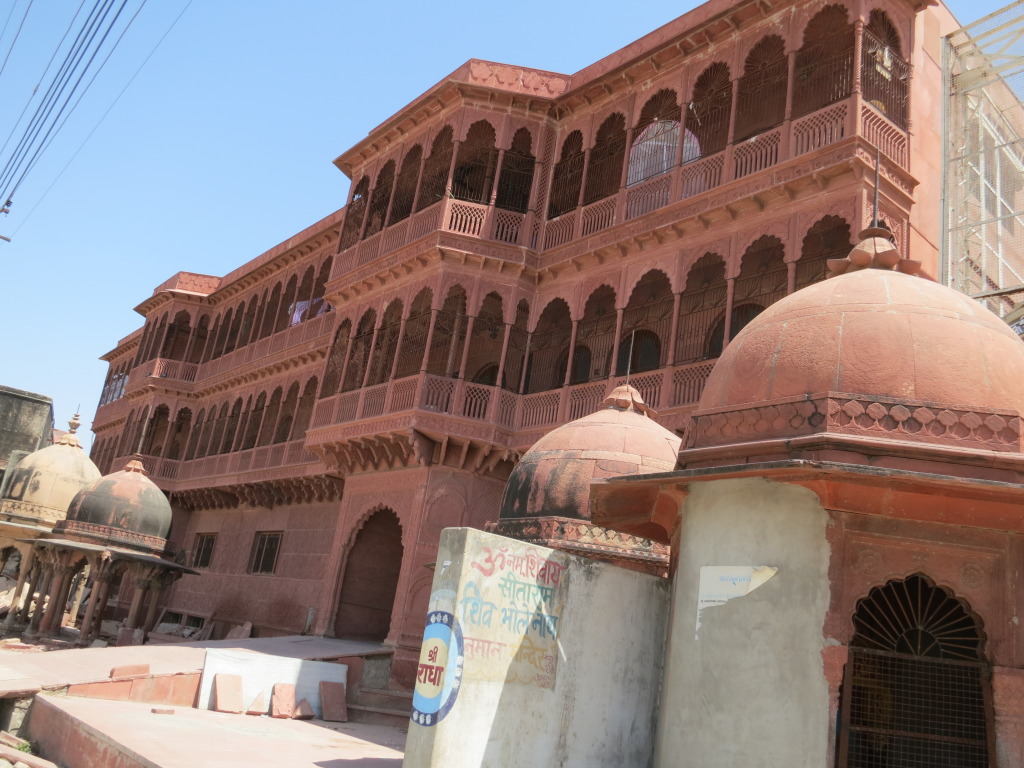
Gopinath Bhavan, the temple and “ladies ashram” where Syamarani didi and her followers reside while on pilgrimage to Vrindavan, India
The residential red stone temple where I stayed with Syamarani and her wards is called Gopinath Bhavan. It is a ladies’ ashram, meaning men are not permitted to live in its quarters. Most of the devotees I encountered there were American women, ranging in age from eighteen to thirty-five, who had come to Vrindavan on pilgrimage or especially to meet Syamarani didi. Some had husbands staying in nearby temples. The men were allowed to visit Gopinath Bhavan, touching their foreheads to the ground before entering the same room as Syamarani, but they were strictly prohibited from sleeping there.
Vrindavan is believed to be where Krishna lived out his “past-times” as a human, the stories of which form the narrative basis of ISKCON scriptures. It is the movement’s holy city and home to Krishna Balaram Mandir, the most important ISKCON temple in the world. As a result, the city is populated mostly by Americans and Eastern Europeans in pseudo-Indian dress, while Indian locals live in the outskirts and come into the city center to sell cloth, beads, or stuffed dolls representing Krishna. Some Indian Hindus make pilgrimages to Vrindavan just as western Hare Krishnas do. The two groups both visit the ISKCON temples and worship alongside each other in many of the same ways, but they do not otherwise intermingle. One devotee told me that this was a proscription of Prabhupada, who, though Indian himself, told his followers that associating with Indian locals would distract them from their spiritual path.
A few of the younger pilgrims I met in Vrindavan were self-described “Krishna kids,” children of the first generation of Hare Krishnas. But many of the devotees I encountered, both in and outside the temple, came into contact with the religion of their own accord, typically during their late teens or early twenties.
“I was studying philosophy at Bard College in upstate New York,” a temple kirtan (prayer music) player told me. “It made me into a true nihilist. I was convinced there was just no point. Then I started playing kirtan with groups of devotees and gained so much joy. When I read the Vedic philosophy behind it, it all just made perfect sense.”
Other young converts I talked to told similar stories. Many had grappled with depression and substance abuse before “finding Krishna,” typically through a pamphlet or flyer given to them in places like yoga centers or devotees handing out free food on their college campuses.
The women of Gopinath Bhavan spent their days chanting, cooking religiously regulated food, making pilgrimages to nearby holy sites, and shopping. They greeted each other with “Hare Krishna” or “Haribol,” and injected quotations from Prabhupada or their favorite gurus into casual conversation. They signed text messages and emails with “Your Aspiring Servant” and referred to money as “Lakshmi,” the Hindu goddess of currency. When the sun set they would choose one of the many temples in Vrindavan (there are said to be a thousand, though this seems an exaggeration) and dance in front of them, singing the song that gives the group its nickname: “Hare Krishna, Hare Krishna, Krishna Krishna, Hare Hare . . .”
Devotees are encouraged to chant 108 rounds of this phrase as often as they can, all day every day. To help keep count, they carry a string of rosary-like beads of the same number in pouches around their necks. The beads are not allowed to touch the ground or devotees’ left hands. I would often find myself speaking with a follower and notice one hand moving inside the pouch—they were chanting in their minds while talking to me.
In the movement’s early years, George Harrison of the Beatles became an enthusiastic devotee and funded the publication of the group’s pamphlets and religious literature, helping ISKCON gain international recognition. By the 1970s, the movement was able to afford missions to the USSR in order to “enlighten” those disillusioned by the Soviet regime. While Hare Krishnas live everywhere around the world, with major concentrations in North American and European cities, their largest communities to this day are in Russia. In the heart of Vrindavan, I saw hundreds of blonde, Eastern European women floating by in flowing pastel “gopi dresses,” which are meant to evoke the uniforms of Krishna’s flirtatious milkmaid servants. All around the world, devotees dance in squares and in parades, and hand out pamphlets and free vegetarian food. They speak softly, overusing words like “ecstatic” and “divine,” and they are almost always smiling.
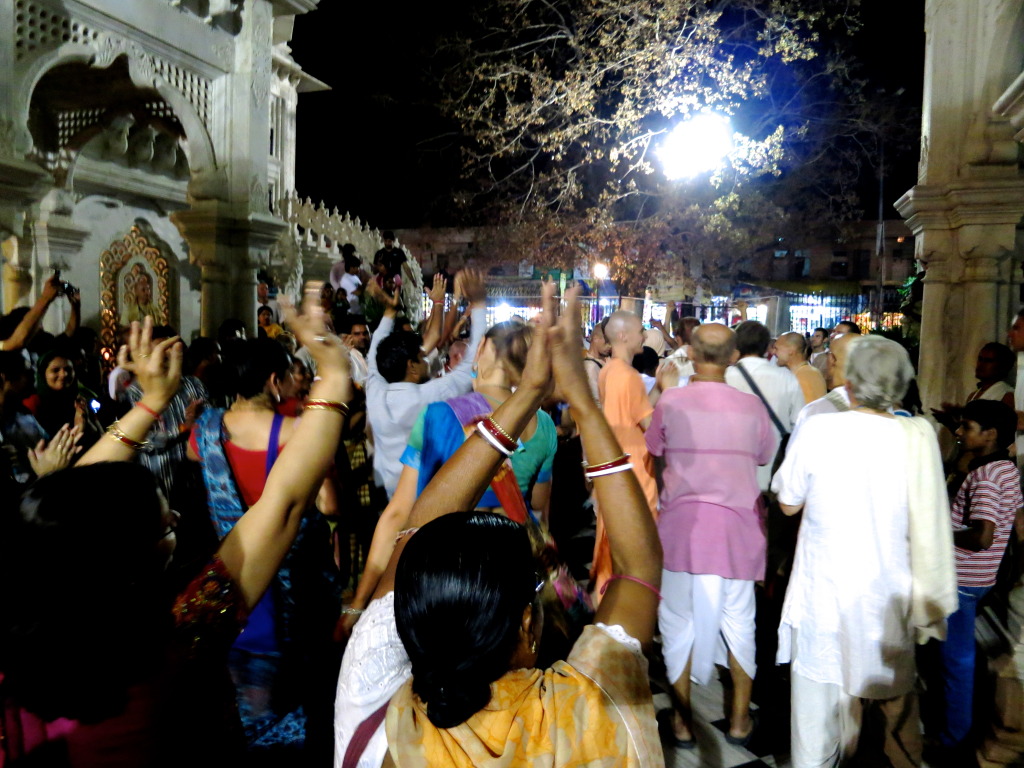
Hare Krishnas dance and chant inside Krishna Balaram Mandir, ISKCON’s principal temple in Vrindavan, India
Krishna Consciousness is at once a more orthodox and more westernized version of the ancient Hindu sect of Gaudiya Vaishnavism. In designing its philosophy, Prabhupada set out to appeal to the demographic that first joined him in Tompkins Square Park. Gaudiya Vaishnavas, and therefore Hare Krishnas, believe Krishna to be the “one true god” and all other gods to be manifestations of him. It’s likely this belief helped make Krishna Consciousness more digestible to westerners raised in monotheistic faiths, relative to most other, more pantheistic forms of Hinduism. The same goes for Prabhupada’s approach to scripture. He set about reworking Vedic texts into less enigmatic and more forthrightly allegorical stories, similar to New Testament parables, only much more playfully sexual.
Prabhupada also crafted a set of commandments based on Hinduism’s “four legs of dharma,” traditional guidelines on character and conduct, but his own terms were stricter and concerned specific behavioral proscriptions: no eating meat, no gambling, no consumption of intoxicants, and no “illicit sex”—in other words, either monogamous, heterosexual marriage or no sex at all. Prabhupada also emphasized the necessity of spreading the word about Krishna Consciousness and gaining devotees.
For more than forty years, the movement has succeeded in attracting converts who were inspired by the spiritual experimentation of the 1960s but had become disenchanted with the period’s excesses. Now, many of those converts are raising children of their own. One of the clearest outward signs of the movement’s transformation over time is the difference in how younger devotees dress. Prabhupada instructed male followers to mimic the Gaudiya Vaishnavas of the fifteenth century: saffron robes, shaven heads except for a long, saucer-sized patch on top gathered into a ponytail, a “U” of white paint and a bindi on the forehead. Women sport similar face paint but usually wear long skirts with t-shirts and a dupata, or scarf, wrapped diagonally around the chest and shoulder like a sari.
Recently, though, many devotees, especially those in urban areas, have abandoned all but their beads, becoming largely indistinguishable from non-devotees. At the movement’s height, many Kare Krishnas earned a living by working in their communities’ restaurants, schools, and specialized Krishna Conscious shops. But growing populations have in many places made insularity difficult to preserve. Many dress in suits and work in offices, or wear t-shirts and run bakeries. They no longer sing and dance in airports like they used to, choosing instead to worship in local temples or in the privacy of their homes.
For Krishna kids, greater integration with mainstream society is a fact of life to a far greater degree than it was for their parents. During nightly electrical blackouts that plagued Gopinath Bhavan during the time I stayed there, when the air was too hot and filled with mosquitoes to sleep, I stayed up and talked with Sita dasi, whose temple cell I was sharing.
Sita was in Vrindavan on pilgrimage, but she lives and works in Florida as a customer service representative for an online retailer. Though she was nineteen and the youngest woman in the temple, she was passionately protective of her fellow female devotees. I learned that just before I arrived, Sita had lashed out physically at a young monk whom she believed to have wronged one of her friends and violated his religious duties.
Sita’s parents were original initiates of Prabhupada, a position that accords them considerable respect in the Hare Krishna community. Still, she thinks the evolution of devotees’ lifestyles is a positive and necessary change.
“I was always taught it is wise to act according to time, place, and circumstance,” she told me. “Chanting publicly in the streets was a very effective method of propagating our movement in the 1960’s, [but] in current times . . . you are more likely find Hare Krishna devotees at colleges, universities, TED Talks, and Conscious yoga festivals.”
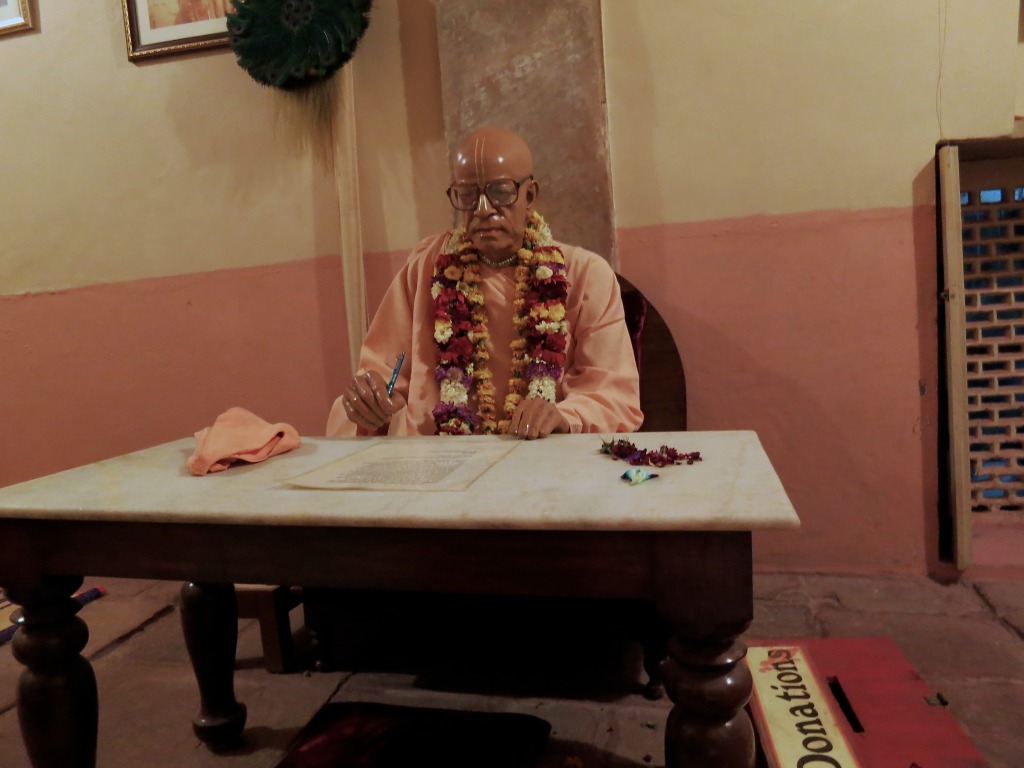
Plastic sculpture of Prabhupada, the late founder of ISKCON, in the temple cell where he stayed during trips to Vrindavan, India
That’s not to say you won’t still find Hare Krishnas in their accustomed haunts, especially in New York, in Union or Times Square or preaching to smokers outside bars near the first-ever ISKCON temple on 2nd Avenue and East 2nd Street, but they are nowhere near as prevalent as they were decades ago. I wondered whether declining visibility was primarily a matter of assimilation and not decreasing numbers.
“We haven’t given up on taking to the streets altogether,” Sita assured me when I brought this up with her. “It’s still something we love to do.”
According to the 1996 Britannica Book of the Year, the last census to report independently on the movement’s demographics, ISKCON was estimated to operate almost six hundred centers and temples around the world, as well as more than fifty schools and almost a hundred specialized restaurants. According to the movement’s online databases, every one of those figures is believed to have increased, yet ISKCON has still never undertaken an official tally of its members worldwide.
There’s little clear agreement as to why, but devotees can sometimes give surprising estimates on the size of their own ranks. Sita dasi told me that the “closest servant” of her own guru, Srila Narayan Maharaja, kept a record of the number of people he personally initiated, which she said exceeded 300,000.
“I can’t tell you how accurate that is,” she conceded. “Our movement, though large, is not what you would call organized.”
Crowds estimated at anywhere between 14,000 and 25,000 have been known to gather for an important Krishna Conscious festival at an ISKCON resort in India in recent years. Still, that’s only a fraction of the 300,000 Maharaja is claimed to have welcomed into the faith all by himself.
Sita, for her own part, belongs to an offshoot Krishna Conscious sect called the International Pure Bhakti Yoga Society (IPBYS), which formed after Prabhupada’s death in 1977. IPBYS members objected to the way that the Governing Body Commission, an eleven-member council of western gurus that Prabhupada appointed to govern ISKCON after his death, steered the movement in the 1970s.
After the splintering, ISKCON faced a number of legal troubles, including a 1984 brainwashing lawsuit that reached the Supreme Court before being dismissed; charges of murderous conspiracy and racketeering against Kirtananda Swami, an ISKCON leader who was expelled from the group in 1987; and, as late as 2001, a $400 million lawsuit filed by alleged victims of abuse in ISKCON temple schools. While all of these charges were ultimately dropped or settled out of court, they contributed to the organization’s filing for Chapter 11 bankruptcy in 2008.
These tribulations also contributed to younger and older devotees alike choosing to lead less conspicuous lifestyles. A middle-aged Hare Krishna from the movement’s founding generation, whom I’ll call Manorama dasa as he asked me not to use his real name, described himself as an “initiated plain-clothes devotee.” The only visible signs of his faith are a string of tulsi-wood beads around his neck and the prayer beads he keeps in a pouch on his belt.
“In the ’60s, distinguishing ourselves was important,” Manorama told me, his fingers moving along his string of beads as he spoke. “Many of us had been scared by the total freedom of being a hippie—being able to wear and do and take anything you want, sleep with whoever. We needed a total, dictated structure.”
In his view, while that hermetic lifestyle was a positive feature of the movement during Prabhupada’s lifetime, it quickly encouraged corruption after his death.
“Prabhupada could handle us in our isolation from society—we didn’t need it when we had him. But most other swamis [high-level gurus] aren’t yet liberated souls, and with them our isolation stopped being a privilege and became a danger. If something went wrong, we didn’t know where to go.”
Manorama says that by the ’80s, non-devotees began to view him not just as a cult member but as a cult victim. Strangers and acquaintances avoided or pitied him due to his clothes, afraid he would preach or ask them for help. Manorama increasingly found he was unable to engage in productive conversations about Krishna Consciousness. It was then that he and many of his peers abandoned their robes and shaved heads. In the end, Manorama thinks this integration with society is for the best.
“Consciousness is becoming an everyday faith, like Judaism or Buddhism,” he explains. “This is the natural evolution of any religion. We of course are still spreading it, not by chanting to strangers now, but by talking about it with our friends and customers. Today, this is a more effective method.”
Sita, Govinda, and the rest of Syamarani’s followers are not plain-clothed in the slightest. The days we spent shopping in Vrindavan were so they could stock up on Indian clothes to wear every day back in America, where they would also paint their foreheads and wrap themselves in scarves. But all three women have chosen to remain in relatively enclosed communities where they run little risk being judged for their open devotion.
It’s different for their city-dwelling counterparts, many of whom, like Manorama, have adopted a subtler approach both to living and spreading their faith. As these Hare Krishnas adapt their practices to integrate more seamlessly with modern life, modern life is simultaneously becoming more welcoming. In New York City, many non-devotees are taking small spoonfuls of Krishna Consciousness already, often unbeknownst to them. The Doughnut Plant in Chelsea serves traditional prashadam doughnuts, and classes at Yoga to the People conclude with a few rounds of chanting “Hare Krishna Hare Rama.”
These are small developments, easily dismissed as signs of the movement’s dissolution as it is absorbed by the mainstream. But you could see them less cynically, too, as more contemporary and possibly more effective ways of enacting one of Prabhupada’s original tenets: the spreading of Krishna Consciousness.
An acquaintance of mine recently told me that his personal trainer had given him some yoga books, one of them an introduction to Krishna Consciousness. The book, he said, outlines the three sources of love: Yourself, the Beloved, and the Combination. It sounded to me like a far cry from Vedic scripture—but not too far.
“It’s pretty simple, you know?” he remarked, pensively rubbing the “carpe diem” tattoo on the back of his neck. “Beautifully simple.”
*
Ema O’Conno r is a New York–based writer whose work has appeared in the Guardian, Women Under Siege, NYTimes.com, XOJane, Quarto Literary Magazine, and Manuscrypt Magazine. Follow her on Twitter @o_ema.
r is a New York–based writer whose work has appeared in the Guardian, Women Under Siege, NYTimes.com, XOJane, Quarto Literary Magazine, and Manuscrypt Magazine. Follow her on Twitter @o_ema.

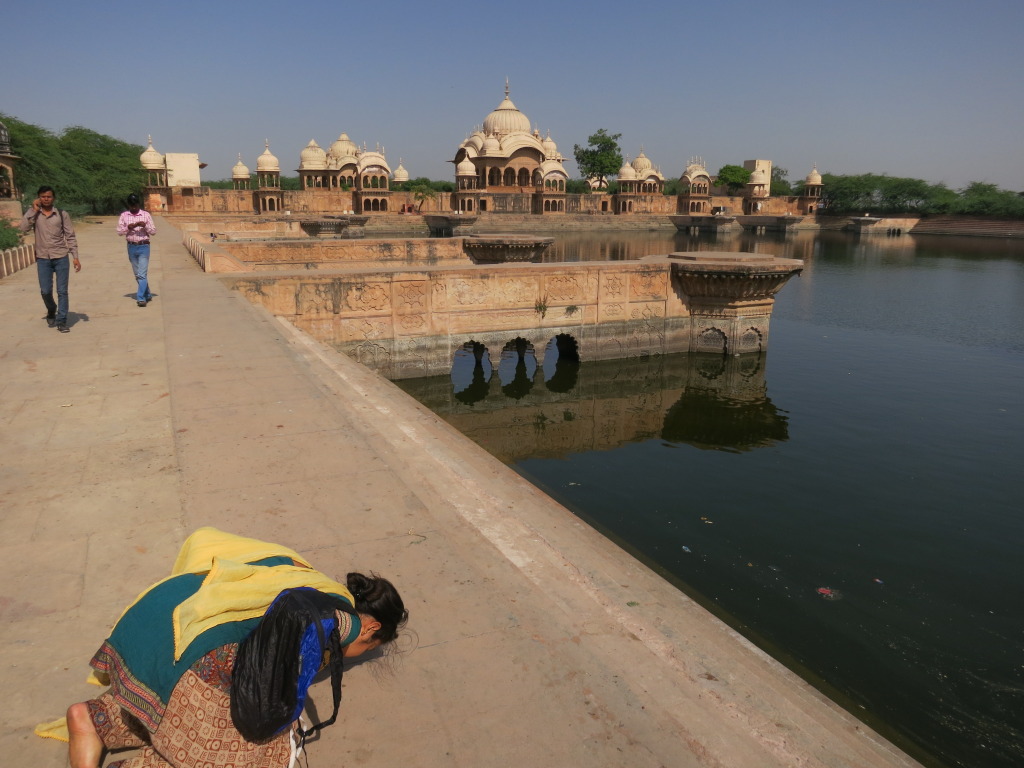
One thought on “The Hare Krishna Movement’s Midlife Crisis”